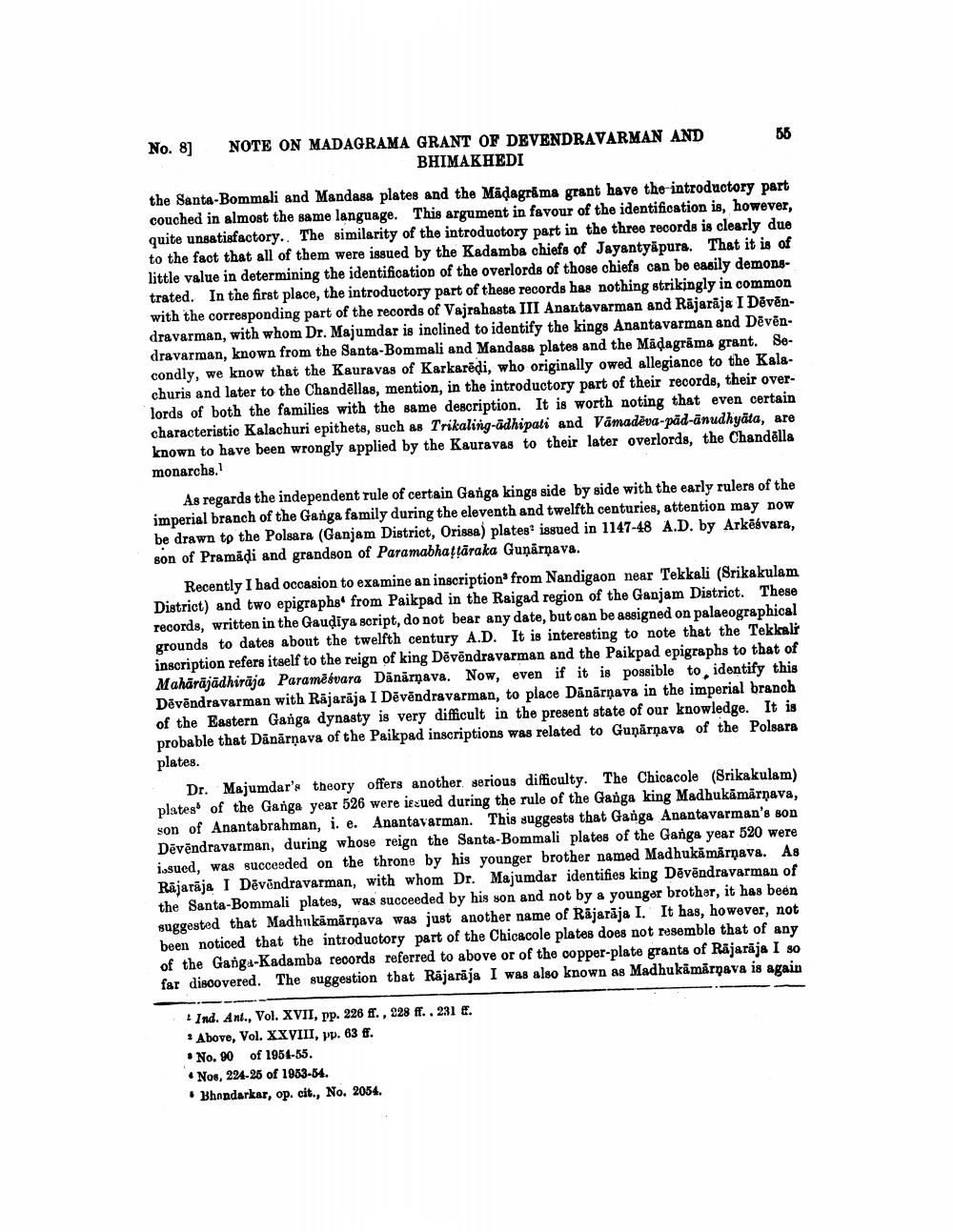________________
No. 8)
56
NOTE ON MADAGRAMA GRANT OF DEVENDRAVARMAN AND
BHIMAKHEDI
the Santa-Bommali and Mandasa plates and the Madagrāma grant have the introductory part couched in almost the same language. This argument in favour of the identification is, however, quite unsatisfactory.. The similarity of the introductory part in the three records is clearly due to the fact that all of them were issued by the Kadamba chiefs of Jayantyäpure. That it is of little value in determining the identification of the overlords of those chiefs can be easily demonstrated. In the first place, the introductory part of these records has nothing strikingly in common with the corresponding part of the records of Vajrahasta III Anantavarman and Rājarāja I Dévēndravarman, with whom Dr. Majumdar is inclined to identify the kings Anantavarman and Dēvēndravarman, known from the Santa-Bommali and Mandasa plates and the Madagrāma grant. Secondly, we know that the Kauravas of Karkarēdi, who originally owed allegiance to the Kalschuris and later to the Chandellas, mention, in the introductory part of their records, their overlords of both the families with the same description. It is worth noting that even certain characteristic Kalachuri epithets, such as Trikaling-adhipati and Vamadeva-päd-ānudhyāta, are known to have been wrongly applied by the Kauravas to their later overlords, the Chandēlla monarchs,
As regards the independent rule of certain Ganga kings side by side with the early rulers of the imperial branch of the Ganga family during the eleventh and twelfth centuries, attention may now be drawn to the Polsara (Ganjam District, Orissa) plates issued in 1147-48 A.D. by Arkēsvara, son of Pramadi and grandson of Paramabhattāraka Gunārņava.
Recently I had occasion to examine an inscription from Nandigaon near Tekkali (Srikakulam District) and two epigraphs from Paikpad in the Raigad region of the Ganjam District. These records, written in the Gaudiya script, do not bear any date, but can be assigned on palaeographical grounds to dates about the twelfth century A.D. It is interesting to note that the Tekkali inscription refers itself to the reign of king Dēvēndravarman and the Paikpad epigraphs to that of Mahārājādhiraja Paramēsvara Dänārnava. Now, even if it is possible to identify this Dēvēndravarman with Rājarāja I Dēvēndravarman, to place Dānārņava in the imperial branch of the Eastern Ganga dynasty is very difficult in the present state of our knowledge. It is probable that Dānārņava of the Paikpad inscriptions was related to Guņārņava of the Polsara plates.
Dr. Majumdar's theory offers another serious difficulty. The Chicacole (Srikakulam) plates of the Ganga year 526 were iecued during the rule of the Ganga king Madhukāmārnava, son of Anantabrahman, i. e. Anantavarman. This suggests that Ganga Anantavarman's son Dévēndravarman, during whose reign the Santa-Bommali plates of the Ganga year 520 were issued, was succeeded on the throne by his younger brother named Madhukāmärņava. As Rājaraja I Dēvindravarman, with whom Dr. Majumdar identifies king Dēvēndravarman of the Santa-Bommali plates, was succeeded by his son and not by a younger brother, it has been suggested that Madhukāmārņava was just another name of Rājarāja I. It has, however, not been noticed that the introductory part of the Chicacole plates does not resemble that of any of the Ganga-Kadamba records referred to above or of the copper-plate grants of Räjarāja I so far discovered. The suggestion that Rajaraja I was also known as Madhukamārnava is again
Ind. Ani., Vol. XVII, pp. 226 ff., 228 ff.. 231 €. : Above, Vol. XXVIII, pp. 63 ff. • No. 90 of 1954-55.
Nos, 224-25 of 1963-64. • Bhandarkar, op. cit., No. 2054.




